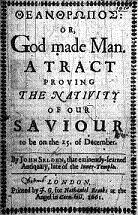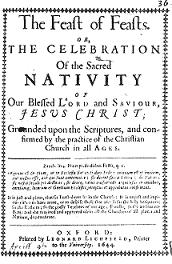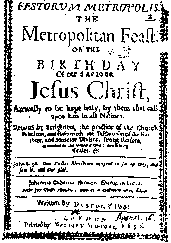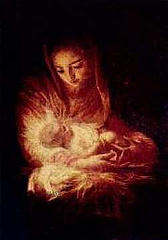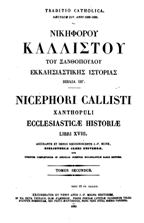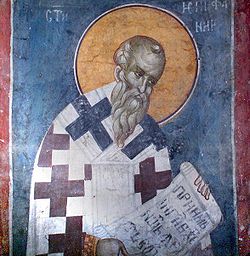Matthew Chapter Two
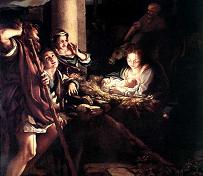 The
Nativity of Christ The
Nativity of Christ & Death of Herod the Great by Kurt Simmons, JD |
[Editor's note: We are writing a commentary on the book of Matthew. The following is a draft of chapter two. We believe it provides the clearest, most concise evidence of Chris's December 25th birth unearthed to date. Although the whole chapter can and should be read with profit, for comments specifically bearing upon the date of Christ's birth and the death of Herod, see vv. 9-23.]
Having established Jesus’ genealogy and claim to the Davidic
throne in the preceding chapter, Matthew provides the historical
details of Christ’s birth, punctuating the narrative with
accounts of prophetic fulfillment.
1 – Now when Jesus was born
Matthew opens his discussion of
Nativity with the arrival of the Magi. The Greek term here is
gennhqentoj,
“having been born,” perfect tense, showing completed action in
the past. Thus, Jesus was already born when the wise men
arrived. The question is how long after his birth until they
arrived? It is often assumed that the wise men found Christ in
the manger at Bethlehem the night of his nativity. But this is
contradicted by v. 11, which says they found him in a
house, not manger.
Hence, the wise men clearly did not arrive the night of Jesus’
birth. At the other extreme, based upon v. 16, it is sometimes
supposed the wise men arrived as much as
two years after Jesus’
birth. However, this cannot be reconciled with Luke, on the one
hand, who places Jesus’ thirtieth birthday in A.D. 29 (Lk. 3:1,
23), making his birth occur in 2 B.C., or Josephus, on the other
hand, who places Herod’s death in 1 B.C. Since Jesus was born
while Herod was still alive and there were not two years between
his birth and Herod’s death, the Magi could not have arrived two
years after Jesus’ birth. As we shall see, there were in fact
only several months between Jesus’ winter birth and Herod’s
death shortly before Passover the following spring.
in Bethlehem of Judaea
Bethlehem was prophesied to be the birth place of the Messiah (see v. 5). Bethlehem means “house of bread,” perhaps in veiled prophecy of the nativity of him who is the “bread of life” (Jn. 6:48). It was anciently known as Ephrath (Gen. 35:16; 48:7; Ps. 132:6), and was the place where Rachel died and was buried (Gen. 35:19; 48:7); it was also where the story of Ruth took place, and was the home and the city of David (I Sam. 16:1, 4; Jn. 7:42). However, Bethlehem was not the home of Joseph or Mary. Luke informs us that the couple made their home instead in Nazareth of Galilee (Lk. 1:26; 2:39). According to Luke, it was in obedience to the decree of Caesar Augustus “that all the world be taxed” that Joseph travelled to Bethlehem to be taxed with Mary his espoused wife “being great with child” (Lk. 2:1-7). Luke tells us further, that this taxing was “first made when Cyrenius was governor of Syria” (Lk. 2:2). The word translated tax in these passages is from the Greek apografesqai, which means to “write out” “enter in a list” or “register,” and can therefore be translated either as “census” or “registration.” When translated as census, it is usually associated with a tax. The difficulty here is that the tax of Cyrenius did not occur until A.D. 6, following the banishment of Herod’s son, Archelaus, when it provoked the sedition of Judas of Galilee.
“Now Cyrenius, a Roman senator, and one who had gone through other magistracies, and had passed through them till he had been consul, and one who, on other accounts, was of great dignity, came at this time into Syria, with a few others, being sent by Caesar to be a judge of that nation, and to take an account of their substance. Coponius also, a man of the equestrian order, was sent together with him, to have the supreme power over the Jews. Moreover, Cyrenius came himself into Judea, which was now added to the province of Syria, to take an account of their substance, and to dispose of Archelaus's money; but the Jews, although at the beginning they took the report of a taxation heinously, yet did they leave off any further opposition to it, by the persuasion of Joazar, who was the son of Boethus, and high priest; so they, being over-persuaded by Joazar's words, gave an account of their estates, without any dispute about it. Yet was there one Judas, a Gaulonite, of a city whose name was Gamala, who, taking with him Sadduc, a Pharisee, became zealous to draw them to a revolt, who both said that this taxation was no better than an introduction to slavery, and exhorted the nation to assert their liberty.”[1]
But as these events were several years too late, and as Luke knew of the revolt of Judas of Galilee (Acts 5:37), the better view is that the apografesqai which brought Joseph and Mary to Bethlehem was not a census for taxation, but a registration. Josephus reports just such a registration that occurred the year Herod died, when Saturninus was still president of Syria, before he was succeeded by Quintilius Varus, in which all the people of the Jews gave an oath of their good will and allegiance to Caesar:
“These are those that are called the sect of the Pharisees, who
were in a capacity of greatly opposing kings. A cunning sect
they were, and soon elevated to a pitch of open fighting and
doing mischief. Accordingly, when all the people of the Jews
gave assurance of their good-will to Caesar, and to the king’s
government, these very men did not swear, being above six
thousand; and when the king imposed a fine upon them, Pheroras’s
wife paid their fine for them.”[2]
We believe this is the registration referred to by Luke. The term translated “governor” in Lk. 2:2, is hegemoneuontoj, and is the root of our English word hegemon, and can signify either a governor (legatus or praeses), as it is usually translated, but also an imperial commissioner or procurator (quaestor). The same word is used in this later sense of Pilate in Lk. 3:1. Given that the term might apply equally to either of these important offices, it is likely that Cyrenius first served as hegemon associated with Saturninus in the government of Syria, and a second time at the taxation, which led to the revolt of Judas of Galilee. This seems to be corroborated by Tertullian, who wrote in the second century that the registration “had been taken in Judea by Sententius Saturninus.”[3] The registration was likely prompted by Augustus being honored by the Roman senate, the equestrian order, and the whole people of Rome, with the title Pater Patriae (Father of the Country). The title was given to Augustus February 5, during his thirteenth consulship, which answers to 2 B.C. and coincides with Saturninus’ presidency of Syria.[4] Paulus Orosius describes the whole affair in reference to Luke 2:2 as follows:
“Augustus ordered that a census be taken of each province everywhere and that all men be enrolled…This is the earliest and most famous public acknowledgment which marked Caesar as the first of all men and the Romans as lords of the world, a published list of all men entered individually…This first and greatest census was taken, since in this one name of Caesar all the peoples of the great nations took oath, and at the same time, through the participation in the census, were made a part of one society.”[5]
|
in the days of Herod the king, This is Herod the Great, as distinguished from Herod Antipas, tetrarch of Galilee, son of Herod by his wife Malthace, and Herod Philip, tetrarch of Iturea and Trachonitas, Herod’s son by Mariamne (Matt. 14:1; Lk. 3:1). Regarding Herod Archelaus, see comments at v. 22. Herod the Great must also to be distinguished from Herod Agrippa I (Acts 12:1), king of Judea and Samaria, grandson of Herod the Great by Aristobulus, and Herod Agrippa II, great grandson of Herod the Great, who was king of Chalcis, his sister, Bernice, being queen (Act 25:13). |
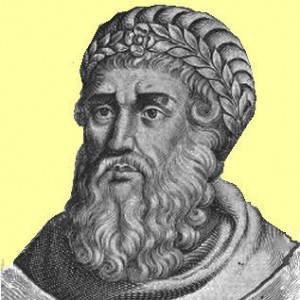 |
Herod the Tetrarch ruled Galilee during the Lord’s
ministry; it was he that beheaded John the Baptist and to him
that Pilate sent Jesus at his trial (Lk. 23:6, 7). After the
death of Tiberius, Gaius Caligula made Herod Agrippa I king of
Ituria, Trachonitis, and Abilene, which had been the tetrarchies
of Philip and Lysanias (Lk. 3:1).[6] Agrippa I
was present in Rome when Caligula was murdered and helped bring
Claudius Caesar to power. Claudius rewarded Agrippa by expanding
his dominions to include all the lands previously ruled by Herod
the Great (Judea and Samaria), which had been divided amongst
his sons.[7] Agrippa I
persecuted the church briefly, putting to death James the
brother of John, and sought also to slay Peter (Acts 12:1-19).
The death of Agrippa I is recorded by Josephus, whose account
accords perfectly with Luke’s record in Acts (Acts 12:20-25).[8] Herod
Agrippa II was but a youth when his father died and was deemed
too young to manage his kingdom. Hence, Claudius returned Judea
to a province, and made Agrippa II king of his uncle’s dominions
(Chalcis) when he was dead. Agrippa’s sister, Bernice, was queen
with her brother, being the widow of her uncle, her father’s
brother (Acts 25:13).[9] Agrippa II
assisted Vespasian in the Jewish war and served Titus at the
destruction of Jerusalem.[10] Following
the war, he went to Rome where he was given the rank of praetor.
Bernice became the lover of Titus, cohabiting with him in the
palace under an apparent expectation of marriage. However, the
Roman people were scandalized, and Titus was forced finally to
send her away, only to have her return again when he was
emperor.[11] Thus far
the posterity of Herod the Great and the Herods mentioned in the
gospels and Acts.
Herod the Great first came to
power by his father, an Idumean named Antipater, who had secured
the government for Hyrcanus II, but at the cost of the nation’s
independence. Beginning with the Babylonian captivity in 586
B.C., the Jewish nation was under foreign domination. It
regained its independence briefly (142 B.C.) under the period of
the Greeks,[12] but
through intestine disputes soon found itself under the power of
Rome. The government of the Jews had been combined in the high
priest by Aristobulus, son of John Hyrcanus, who was the first
of the priestly line to done a crown. Aristobulus was followed
in the government by Alexander, who left two sons: Hyrcanus II,
the elder, and Aristobulus II, the younger. The government came
first to Alexander’s widow, queen Alexandra, who made Hyrcanus
II high priest because he was the elder. But when the queen
died, Aristobulus made war against his brother. In the contests
that followed, the parties each sent ambassadors to Pompey the
Great, seeking his favor and military support. The ambassador
for Hyrcanus was Antipater, Herod’s father. When the parties had
submitted their causes to Pompey, Aristobulus fled to Jerusalem,
shutting up the city against Pompey before he gave any decision.
Aristobulus later capitulated and surrendered to Pompey, but the
members of his party would not accept his capitulation or
surrender the city. Angered, Pompey besieged the city, taking it
after a siege of five months (63 B.C.). Pompey confirmed
Hyrcanus in the high priesthood, but joined the country to the
province of Syria under a president, ending national
independence. Though Hyrcanus was high priest, the country was
managed by Antipater.
Hyrcanus and Antipater thus
continued in the government until the civil war that ended the
Roman republic (49 B.C.) and brought Julius Caesar to supreme
power. Following his defeat at Pharsalus (48 B.C.), Pompey fled
to Egypt. Caesar pursued Pompey there, only to find when he
arrived that Pompey had been assassinated by the Egyptians.
Caesar also found king Ptolemy XIII making war against his
sister and coregent, Cleopatra, whom he had expelled from the
throne shortly before. Egypt was a protectorate of Rome; Caesar
was consul that year and attempted to have the parties settle
their dispute before him in process of law, rather than by armed
force. Thinking it unseemly for a king to submit the contest to
Caesar’s arbitrage, Ptolemy attacked Caesar’s forces with the
royal army. In the war that followed, Antipater came to Caesar’s
assistance with numerous recruits, even turning a battle that
helped save the day. Victorious, Caesar settled the government
of Egypt on Cleopatra as queen, then came to Syria the following
summer and settled the government there (47 B.C.). He rewarded
Antipater with the procuratorship of Judea; Antipater in turn
made his son, Phasaelus, governor of Jerusalem; Herod was given
charge of Galilee being twenty-five years of age.[13] This is
important because it dates Herod’s birth to the summer of 72
B.C., allowing us to date his death shortly before Passover at
age 70 to 1 B.C.
After the death of Julius Caesar (44 B.C.) and the defeat of Cassius and Brutus (42 B.C.), Marc Antony marched into Asia, then Syria where he met Cleopatra and fell in love (41 B.C.). At the same time, Herod gained Antony’s friendship with large gifts of money, and Antony made Herod and his brother Phasaeslus tetrarchs. But in the second year, the Parthians invaded the land, took Hyrcanus and Phasaeslus captive, and installed Antigonus, the son of Aristobulus, as king. Herod fled to Rome, where Antony and Octavian Caesar caused the Roman senate to make Herod king. Josephus places this in the one hundred eighty-fourth Olympiad in the consulship of Calvinus and Pollio (40 B.C.),[14] but Appian dates it to 39 B.C.[15] Herod then returned to Palestine and, with the help of the Roman general Sossius, after three years finally captured Jerusalem. Herod procured the execution of Antigonus by Marc Antony shortly thereafter. Josephus dates this to the one hundred eighty-fifth Olympiad during the consulship of Agrippa and Gallus (37 B.C.), but also dates it to exactly 27 years from Jerusalem’s fall to Pompey, which translates to 36 B.C.[16] This latter date seems to be corroborated by Dio Cassius, who says the Romans “accomplished nothing worthy of note” in the area in 37 B.C.[17] It is also consistent with Josephus’ statement that the death of Antigonus concluded the Hysmonean dynasty one hundred twenty-six years after it was set up in 162 B.C., having held the high priesthood for three years and three months.[18] Three years and three months from 36 B.C. would place the Parthian capture of Hyrcanus to the summer, and Herod’s appointment as king in Rome to the winter, of 39 B.C. A final note pointing to Herod’s receiving the kingdom in late 39 B.C. is the following statement of Josephus:
“The number of high priests from the days of Herod until the day
when Titus took the temple and the city, and burnt them, were in
all twenty-eight; and the time also that belonged to them was a
hundred and seven years.”[19]
Titus captured the temple and
destroyed Jerusalem in August, A.D. 70. Reckoning backward one
hundred seven years from this date will bring us to 38 B.C.,
which would have been the first regnal year of Herod following
his appointment as king in Rome in winter 39 B.C. Thus, began
the reign of Herod the Great. He died in 1 B.C. several months
after the birth of Christ, having reigned 37 years from being
declared king by the Romans, but 34 years from the capture of
Jerusalem and death of Antigonus. (See comments at v. 22.)
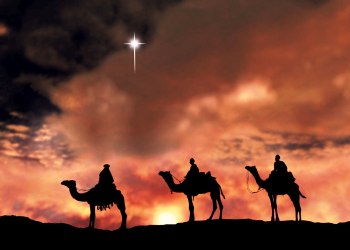 |
behold, there came wise men from the east to Jerusalem, Herodotus gives the name of the tribes of the Medes as Busae, Parataceni, Struchates, Arizanti, Budii, and the Magi.[20] The term rendered “wise men” here is from the Greek magio, or “Magi,” and is derived from the tribe of the Medes that carries the same name. |
This tribe was
occupied in interpreting dreams, astrology, and the religious
rites of their people, similar to the Chaldeans among the
Babylonians, and the tribe of Levi among the Jews.It is likely that it is to men of this tribe the second chapter
of Daniel refers when it mentions the wise men, astrologers,
magicians (LXX,
magwn),
Chaldeans, and soothsayers of Nebuchadnezzar’s court who could
not interpret the king’s dream (Dan. 2:27).
This may be the link that explains why these men came
from the east seeking the Christ child.
Beginning with verse four of
Daniel chapter two, following the word “Syriack,” the Hebrew
suddenly stops and the book is written in Aramaic through the
end of chapter seven. Aramaic was the international language of
diplomacy and commerce of the day.[21] These
chapters were recorded in Aramaic that they might be known and
read by the Gentile peoples of the Babylonian and Mede-Persian
empires, during whose days they were composed. God wrought many
mighty works in the Babylonian and Mede-Persian courts, which
are recorded in these chapters, including the events surrounding
Nebuchadnezzar’s dream (Dan. 2), the rescue of the three young
men (Dan. 3), the king’s madness and conversion (Dan. 4), the
hand that appeared on the wall during Belshazzar’s feast (Dan.
5), and God’s rescue of Daniel from the lion’s den (Dan. 6).
Moreover, in addition to the miraculous circumstances attending
Nebuchadnezzar’s dream, the prophecy of Daniel two, and its
companion prophecy in chapter seven, foretold the succession of
world empires until the kingdom of God, and therefore served as
timelines unto the birth of Christ. Given the mighty works of
God in the royal court and their publication in Aramaic, we may
imagine that there were many proselytes among the nations,
including ancestors of the Magi here, who learned of Christ’s
coming from the writings of Daniel, and were watching for his
birth.
2 – Saying, Where is he that is born King of the Jews? For we
have seen his star
Star, comets, and celestial bodies are commonly associated with
great revolutions in world affairs, and are part of the imagery
used by the prophets to describe cataclysmic judgments and the
rise and fall of earthly powers (Isa. 13:10; 34:1-4; Lk. 21:25;
Rev. 8:10, 12; 9:1). Two passages are traditionally assigned as
predicting that the advent of the Messiah would be attended by a
star. The first is Balaam’s prophecy in Num. 24:17: “A
Star shall rise out of Jacob and a Sceptre shall rise out of
Israel.” The other passage is Isa. 60:3:
“And the Gentiles shall
come to thy light, and kings to the brightness of thy rising.”
Various attempts have been made down through the centuries to
identify the star that led the Magi to Christ by appeal to
natural phenomena and astrological occurrences, typically the
conjunction or massing of planets.[22] Such
attempts proceed upon the assumption that the star was a
regularly occurring phenomenon, repeated at set intervals, which
may be identified by mathematical formula in the same way men
are able to predict lunar and solar eclipses. Against this,
however, it may be urged that the notion the star seen by the
Magi was a conjunction or massing of planets is contradicted by
the plain language of scripture.
By all accounts, the Magi were expert astronomers who probably came
from the area of Media, and would have been thoroughly familiar
with the movements of celestial bodies and the conjunction of
planets. Matthew is very clear that the Magi referred to the
phenomenon that drew them to Jerusalem as a “star.” The
Greek term Matthew employed is "astera" (singular). The term for multiple stars is the plural "asterej" (Rev. 6:13). The Greek phrase for planet is " asthr planhthj" (“a wandering star”) and the plural is “asterej planetej” (Jude 13). If the Magi saw one or more planetary
conjunctions, we would expect them to use language reasonably
calculated to communicate as much. The fact that they described
a single star, and not a planet, or series of conjunctions of
stars or planets, refutes all such notions. Instead, the better
view is that the star
was
a supernatural phenomenon, unlike anything that has occurred
before or since, whose meaning and significance was made known
to the Magi by divine revelation.
in the east
Magi
from the east (apo
anatolwn)
saw the star in the east
(en th anatolh).
This probably signifies the region of Media, then part of the
kingdom of Parthia. From v. 16, we learn that the star
originally appeared two years before. Thus, the arrival of the
Magi at Jerusalem came at the end of a pilgrimage begun two
years before, during which the star seems to have appeared
intermittently at irregular intervals along the way. We learn
from v. 12 that God communicated with the Magi by dreams. Since
the appearance of a star could not, without more, tell the Magi
a king was born or what nation he would rule, we may assume the
meaning of the star was communicated to the Magi by divine
revelation.
and are come to worship him.
They have not come merely to
honor a new-born king, but to worship him, signifying they
understood somewhat the divine nature of the Christ-child. The
word rendered “worship” is from the Greek
proskunew,
“to prostrate oneself in
homage, do reverence to, adore.” Since this would not be the
kind of honor normally shown to a human king of a foreign
nation, this attests to the fact that the Magi were almost
certainly religious proselytes and worshippers of the Lord, like
the Medes, Elamites, and Parthians who came to Jerusalem to
worship at Pentecost following Christ’s ascension (Acts 2:9).
|
3 – When Herod the king had heard these things, Herod the king is set in apposition to him that was born King, whom the Magi had come to worship. Josephus reports that Herod ruled by terror, intimidation, and secret police. It is probably Herod’s spies and informants that carried word of the Magi’s arrival to his ears. Josephus gives the following description, which was typical of Herod’s reign: |
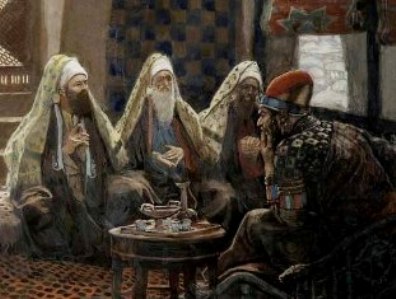 |
“At which time Herod released to his subjects the third part of
their taxes, under pretense indeed of relieving them after the
dearth they had had, but the main reason was, to recover their
good-will, which he now wanted; for they were uneasy at him,
because of the innovations he had introduced in their practices
of the dissolution of their religion, and of the disuse of their
own customs, and the people everywhere talked against him, like
those that were still more provoked and disturbed at his
procedure; against which discontents he greatly guarded himself,
and took away the opportunities they might have to disturb him,
and enjoined them to be always at work; nor did he permit the
citizens either to meet together, or to walk, or eat together,
but watched everything they did, and when they were caught, they
were severely punished; and many there were who were brought to
the citadel Hyrcania, both openly and secretly, and were there
put to death; and there were spies set everywhere, both in the
city and in the roads, who watched those that met together; nay,
it is reported that he did not himself neglect this part of
caution, but that he would oftentimes himself take the habit of
a private man, and mix among the multitude in the night-time,
and make trial what opinion they had of his government; and as
for those that could be no way reduced to acquiesce under his
scheme of government, he persecuted them all manner of ways; but
for the rest of the multitude, he required that they should be
obliged to take an oath of fidelity to him, and at the same time
compelled them to swear that they would bear him good-will, and
continue certainly so to do, in his management of the
government; and indeed a great part of them, either to please
him, or out of fear of him, yielded to what he required of them;
but for such as were of a more open and generous disposition,
and had indignation at the force he used to them, he by one
means or other made away with them.”[23]
he was troubled, and all Jerusalem with him.
Herod was troubled because he was
dying, and his thoughts were for the perpetuation of his kingdom
by settling succession upon his sons, which was threatened by
word of the new-born King.
By the time the Magi arrived,
Herod was in the final weeks of his life. Antipater, Herod’s son
by Doris, had been tried for treason before Quintilius Varus,
who succeeded Saturninus as president of Syria. Condemned, Herod
feared to send Antipater to Caesar for punishment, lest he
somehow escape. Antipater was thus held in the palace prison at
Jericho, and Herod sent letters and ambassadors to Augustus
Caesar to accuse Antipater and learn Caesar’s pleasure
concerning his son. However, while waiting for word from Caesar,
Herod fell gravely ill. This was now about the seventieth year
of his life, and he despaired of recovery. Herod thus made his
will, temporarily settling the kingdom upon his youngest son,
Herod Antipater. Facing death and knowing that he was hated by
the Jews, Josephus reports that Herod “grew fierce, and indulged
the bitterest anger upon all occasions,” and more especially
because of a sedition that now broke out.
Herod had placed a large Roman
eagle above the gate of the temple, which the Jews considered an
affront to their religion. Taking the opportunity of Herod’s
impending death, several prominent rabbis moved the young men to
cut the eagle down. When rumor came that Herod was dead, the
young men made an assault on the temple in broad daylight, and
cut down the eagle. However, the soldiers came upon them
suddenly, and when they had been captured, Herod had them sent
to Jericho, where the leaders were burned alive. Josephus
reports that the night of the rabbis’ execution there was an
eclipse of the moon.[24] This
lunar eclipse is important for dating Herod’s death. For many
years, it was supposed to be the partial lunar eclipse of March
13, 4 B.C. But this has now been thoroughly refuted, and leading
scholarship agrees that this was the full lunar eclipse of
January 10, 1 B.C.
[25]
Herod’s final illness now grew
worse; he thus travelled beyond the Jordon River to bathe in
mineral springs as a curative for his disease. However, when
this failed to improve his health, Herod returned to Jericho,
dying shortly thereafter, never to return to Jerusalem again.
The arrival of the Magi would therefore have occurred about this
time, shortly after the execution of the Rabbis, but before
Herod travelled beyond the Jordan, probably toward the middle of
February, 1 B.C.[26] (See
additional comments at v. 11.)
4 – And when he had gathered all the chief priests and scribes
of the people together, he demanded of them where Christ should
be born.
The Magi came seeking an
infant-King; Herod correctly interprets this in reference to the
promised Christ. Herod’s response indicates that the Magi were
well received and their story credited among the leaders of the
Jews. That they were also brought into the king’s presence (v.
7) bespeaks something of the Magi’s social standing: these were
no mean strangers, but men of sufficient wealth and standing to
find an audience with the king. Like the angelic host that
appeared to the shepherds as told by Luke (Lk. 2:9-14), the star
and arrival of the Magi are heavenly signs testifying that
heaven has come down to earth to reclaim the fallen race of
Adam.
5, 6 – And they said unto him, In Bethlehem of Judaea: for thus
it is written by the prophet, And thou Bethlehem, in the land of
Juda, art not the least among the princes of Juda: for out of
thee shall come a Governor, that shall rule my people Israel.
The chief priests and scribes
cite Micah 5:2 to indicate where Christ should be born. There
are several differences between their paraphrase and the Hebrew
as we possess it. “Land of Judah” replaces “Ephratah,” and
“among the princes” replaces “among the thousands.” The scribes
likely paraphrased it this way for Herod as an incident of
casual speech in answer to his question rather than a
word-for-word quotation. However, it is worth our noting that
Micah’s “thousands” does not refer to the cities and villages of
Judah, but to the captains
of thousands. Moses had divided the people into rulers of
thousands, hundreds, fifties, and tens at the suggestion of his
father-in-law, Jethro (Ex. 18:25). Thus, Micah’s meaning seems
to be that, although comparatively small, from among the
captains of thousands who ruled the people, one would arise from
Bethlehem who would be ruler over all. The marginal reading for
the word “rule” is “feed,” and shows that Christ would not
merely govern, but is the Great Shepherd who would nourish his
people and lead them into paths of eternal life. Micah 5:2 is
also among the Old Testament texts, which show Christ was
divine, for the prophet says that Israel’s ruler would be one
whose “goings forth have been from old,
from everlasting” (cf.
Jn. 1:1; 8:58). It is
likely that the chief priests and scribes did not understand the
meaning of this and that Christ was God incarnate, and therefore
omitted its mention to Herod.
7 – Then Herod, when he had privily called the wise men,
inquired of them diligently what time the star appeared.
Herod has already determined to
murder the Christ-child, and therefore confers secretly with the
Magi, lest word of the conference becoming known alert the holy
family and they conceal themselves from the Magi. The Magi are
thus made Herod’s unwitting agents to catch and destroy the
infant-King. Herod examines the Magi diligently to learn when
the star first appeared, so that he may determine the range of
the child’s age. Herod’s purpose is to get sufficient
information to correctly identify the one he purposes to murder.
8 - And he sent them to Bethlehem, and said, Go and search
diligently for the young child; and when ye have found him,
bring me word again, that I may come and worship him also.
Having plied the Magi for all the
information he could obtain, Herod now sends them to Bethlehem,
where it is supposed the child resides. Herod feigns he is a
religious man, and instructs the Magi to return to him again,
when they have found the child, that he too might pay him
homage. Based upon the time the star first appeared (v. 16), it
is sometimes supposed that Christ was as much as two years old
when the Magi arrived, and Herod’s use of the phrase “young
child” certainly may have contemplated as much. But the word
itself (paidiov)
does not give proof of the child’s age, for Luke uses the same
term for the babe at eight days old when he was circumcised (Lk.
2:21), and again at his presentment in the temple at forty days
of age (Lk. 2:27). Indeed, we believe the record will show that
Christ was less than two months old when the Magi found him.
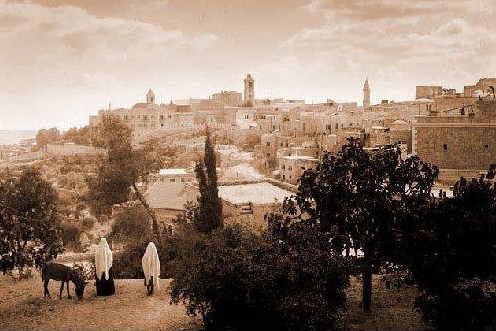 |
9, 10 – When they had heard the king, they departed; and, lo,
the star, which they saw in the east, went before them, till it
came and stood over where the young child was. When they saw the
star they rejoiced with exceeding great joy.
We here find evidence that the
star is a supernatural phenomenon, for it appears again after
some while being unseen, and goes before the Magi, leading them
to the Christ-child. Surely, to urge this was a mere conjunction
of planets is more than the text will bear. |
Bethlehem is only about ten miles
distant from Jerusalem. Since the Magi were specifically
directed there by Herod, we should not imagine this is where the
star led them. Rather, we learn from Luke that, after the
forty-day period of ritual impurity following birth of a male
child, the holy family travelled to Jerusalem, where they made
the necessary offerings for Mary and her first-born son (Ex.
13:2, 12, 13; Lev. 12:2-4, 8), then returned to their home in
Nazareth (Lk. 2:22-24, 39). There are only two options when
these events could have occurred: Before the flight to Egypt, or
afterward, when the holy family returned from exile. The
language of Luke gives every indication that the presentation at
the temple followed immediately upon conclusion of Mary’s period
of ritual impurity. At eight days of age, Jesus was circumcised
(Lk. 2:21), then at forty-days he was presented at the temple
(Lk. 2:22-24). There is no suggestion of any postponement. In
fact, the possibility that the presentation was postponed until
the return from Egypt is expressly contradicted by Matthew, who
says that Joseph, learning Archelaus reigned in Judea in place
of his father, “was afraid to go thither,” and being warned in a
dream, Joseph “turned aside” into Galilee, avoiding Judea
entirely (Matt. 2:22). Thus, there would have been no
possibility of the presentation to occur following the exile.
Since Bethlehem is so near to Jerusalem, and the Magi were
directed there by Herod in any event, and therefore would not
need the star to direct them there, the better view is that the
star was interposed by heaven to direct the Magi to where the
child had removed, viz.,
to Nazareth, where the holy family had returned about forty-five
days after Jesus’ birth.
11 – And when they were come into the house, they saw the young
child with Mary his mother,
We here find confirmation that
the holy family was already returned to Nazareth, for the Magi
found the mother and child in the family house (oikiav),
and not at an inn or the cave at Bethlehem.
and fell down, and worshipped him:
We my note the complete absence
of vernation or homage of any sort to Mary, though present with
the babe. Christ was God incarnate, and therefore the proper
object of worship, which none other can claim. When Cornelius
fell down upon his knees before Peter, the apostle strictly
forbade it, saying, “I myself am also a man” (Acts 10:25, 26).
When the Lyconians sought to offer sacrifice to Paul and
Barnabas, they rent their clothes and restrained the people,
saying, “we also are men of like passions with you, and preach
unto you that ye should turn from these vanities unto the living
God” (Acts 14:15). Yea, even angels forbade men to adore them
(Rev. 19:10; 22:9). If it was forbidden to give homage to Mary
and the person of the apostles, how much more must we imagine it
to be unlawful to render homage to statues and images of them,
or the relics of supposed saints?
and when they had opened their treasures, they presented unto
him gifts; gold, and frankincense, and myrrh.
The presentation of gifts
anticipates the conversion of the Gentiles foretold by the
Psalmist: “The kings of
Tarshish and of the isles shall bring presents: the kings of
Sheba and Seba shall offer gifts. Yea, all kings shall fall down
before him: all nations shall serve him” (Ps. 72:10).
“And the Gentiles shall
come to thy light, and kings to the brightness of thy
risings…the abundance of the sea shall be converted unto thee,
and the forces of the Gentiles shall come unto thee…all they
from Sheba shall come: they shall bring gold and incense; and
they shall shew forth the praises of the Lord” (Isa.
60:3-6). “And I will shake
all nations, and the desire of all nations shall come: and I
will fill this house with glory, saith the Lord of hosts”
(Hag. 2:7). It is traditional to interpret the three gifts of
gold, frankincense, and myrrh as signifying there were three
Magi, but the evidence is inconclusive and it cannot be
certainly known.[27] Gold,
frankincense, and myrrh were precious commodities, but are also
thought to have symbolic value: gold for Christ’s
kingship; frankincense
for his priestly office;
myrrh prefiguring his
anointing and death.
12 – And being warned of God in a dream that they should not
return to Herod, they departed into their own country another
way.
That God deigned to communicate
with the Magi by dream suggests that their pilgrimage to find
the Christ-child was by divine intimation and direction from the
very start, and not by the power of human interpretation
attached to the appearing of the star. Rather than representing
different races and peoples, the Magi have a common country, to
which they now return. It will be thirty years before the Savior
begins his ministry. Meanwhile the Magi, having returned home,
can tell God’s mighty works among their countrymen and help
prepare them for the gospel of Jesus Christ.
|
13 – And when they were departed, behold, the angel of the Lord
appeareth to Joseph in a dream, saying, Arise, and take the
young child and his mother, and flee into Egypt, and be thou
there until I bring thee word: for Herod will seek the young
child to destroy him.
Although no longer in Bethlehem,
the Roman registration would have just concluded, if it was not
still under way. Herod could easily have obtained from
Quintilius Varus records of the registrants, and thus trace the
holy family back to Nazareth where they made their home. Herod’s
kingdom and jurisdiction included Galilee; hence it was not safe
for the holy family to remain in the land. The angel thus
directs Joseph to flee to Egypt, which had been made a Roman
province since the death of Antony and Cleopatra. |
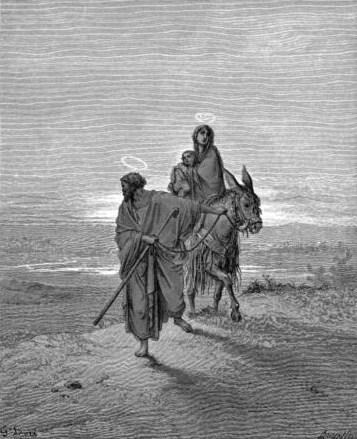 |
14, 15 – When he arose, he took the young child and his mother
by night, and departed into Egypt: and was there until the death
of Herod: that it might be fulfilled which was spoken of the
Lord by the prophet, saying, Out of Egypt have I called my son.
The period between their flight to Egypt and Herod’s death was probably not more than about two months, though they did not return until the government was settled upon Archelaus (Matt. 2:19-23). Based upon the offering at the temple of two turtle doves (Lk. 2:24), it is commonly supposed that Joseph was a poor man. It seems unlikely that Joseph could well afford to support the family in a strange land; the gifts of the Magi thus become heaven’s provision for the family’s flight. There was a large Jewish population in Egypt and Alexandria, which had a large portion of the city assigned to them and were declared its citizens by Julius Caesar.[28] It may be that it was to Alexandria that Joseph, Mary, and baby Jesus had recourse. The prophecy cited by Matthew is from Hosea 11:1:
“When Israel was a child, then I loved him, and called my son
out of Egypt.”
The basic thought or supposition
is that what occurred to Israel the nation was at various points
a prophetic type that found further fulfillment in Christ. The
prophecies and events cited by Matthew (Isa. 7:14; Hos. 11:1;
Jer. 31:15-17) sometimes bear an obvious reference to Christ,
sometimes not. But as no prophecy of scripture is of private
interpretation (II Pet. 1:20, 21), Matthew must be understood as
speaking by authority of the Holy Ghost and not his own
volition, so that what he affirms was being fulfilled in Christ
had been foreordained by God, who set them as ancient landmarks
to mark off the identity of the Messiah.
16 – Then Herod, when he saw that he was mocked of the wise men,
was exceeding wroth, and sent forth, and slew all the children
that were in Bethlehem, and in all the coasts thereof, from two
years old and under, according to the time which he had
diligently inquired of the wise men.
It has been alleged at various times that the Slaughter of the Innocents never occurred, but stands as a piece of anti-Herodian fiction.[29] The chief objection to the verity of Matthew’s account is that it is not mentioned by Josephus, but is the only record we have of the events described. Also, the crime itself seems too barbarous to be believed. But these objections are without merit. There are any number of reasons Josephus might neglect to record the Slaughter of the Innocents, not the least of which being that his primary source for Herod’s reign was Nicolas of Damascus, who was Herod’s friend and personal historian, and was known to misrepresent facts to gratify Herod. Josephus says of Nicolas:
“He wrote in Herod’s lifetime, and under his reign, and so as to please him, and as a servant to him, touching upon nothing but what tended to his glory, and openly excusing many of his notorious crimes and very diligently concealing them.”
[30]Given that Nicolas of Damascus actively concealed the crimes of Herod in his histories, we may assume that he suppressed the Slaughter of the Innocents in deference to his friend, and that Josephus fails to report it because he did not find it in Nicolas’ histories of Herod’s reign. Josephus may also have omitted mention of Herod’s crime, to avoid insulting the Roman people, whose senate had issued the identical decree at the time Augustus was born. Suetonius reports
“A few months before August was born a portent was generally
observed at Rome, which gave warning that nature was pregnant
with a king for the Roman people: thereupon the senate in
consternation decreed that no male child born that year should
be reared.”[31]
The ancient world was steeped in
infanticide, and to expose unwanted infants an accepted norm of
life among the pagan world. The Roman senate being on record as
having ordered the exposure of all male children born in the
compass of an entire year, we can imagine Josephus’ reluctance
to mention the similar crime of Herod. How could Josephus
incriminate Herod for the Slaughter of the Innocents without
also incriminating the Roman senate? His silence here therefore
should not surprise us. That Herod was fully capable of such a
crime is only too apparent. Herod slew three of his sons, his
mother-in-law, his wife’s brother, and his wife; to say nothing
of the countless political opponents he slew, and anonymous
others secreted away to the fortress Hyrcania where they
miserably perished. One of Herod’s last acts was to order that
the elders of the Jews be shut up in the Hippodrome at Jericho
and, upon Herod’s death, be slain, that there might be a general
mourning at his passing.[32]
Clearly, a man of demonstrated ability to slay without mercy his
own sons and family members, and to order the indiscriminate
murder of the nation’s nobility, is fully capable of destroying
the nameless children of others.
But as to the charge that Matthew is the only account we possess of the slaughter of Bethlehem’s babes, here we must beg to differ. St. John makes obvious reference to Herod’s attempt to destroy the Christ-child in his apocalypse:
“And there appeared a great wonder in heaven; a woman clothed
with the sun, and the moon under her feet, and upon her head a
crown of twelve stars: and she being with child cried to be
delivered. And there appeared another wonder in heaven; and
behold a great red dragon, having seven head and ten horns, and
seven crowns upon his heads. And his tail drew the third part of
the stars of heaven, and did cast them to the earth: and the
dragon stood before the woman which was ready to be delivered,
for to devour her child as soon as it was born.” Rev. 12:1-4
Here is unquestionable reference
to Herod’s attempt to slay the Christ-child. The woman is not
Mary, but Zion, the virgin of Israel, the Old Testament
congregation of God’s faithful groaning in travail to be
delivered from sin and death, and from their earthly enemies.
She is pregnant with the promise of the Savior. The dragon is
Leviathan, Rome, the world civil power opposing God and
oppressing his people. Its seven heads and ten horns stand for
the political subdivisions of the Empire: the ten horns are the
ten senatorial provinces created by Augustus in 27 B.C., which
became identifying features of the Empire and its divided rule,
but very likely stand for the whole of its provinces. The seven
heads represent the imperial Caesars from Julius until Galba,
who came to power shortly after the apocalypse was written (Rev.
17:10). Herod was a client king of Rome and his acts are
attributed to the dragon. Thus, although Mark and Luke do not
mention the Slaughter of the Innocents, John does and thus
becomes a witness to the verity of the Matthew’s record.
Finally, there is the testimony of Macrobius. Macrobius wrote an encyclopedic account of Roman culture entitled the Saturnalia in which he records the legends and lore of the holidays marking the Roman calendar. In book two, Macrobius records some of the witting sayings of Augustus Caesar, and there reports:
“On hearing that the son of Herod, king of the Jews, had been
slain when Herod ordered that all boys in Syria under the age of
two be killed, Augustus said, ‘It’s better to be Herod’s pig
than his son.’”[33]
The authenticity of Macrobius’
report is not disputed. However, it is sometimes read to include
Antipater among those who perished in the Slaughter of the
Innocents, which obviously would be incorrect. However,
Macrobius may merely have intended to indicate that Antipater
was executed at the same time the Slaughter of the Innocents was
being carried out. We need not enter into a discussion which is
correct, for by either reading the death of Antipater and
Slaughter of the Innocents were contemporaneous events. This
means that by ascertaining when Antipater died we may also learn
when the Massacre of the Innocents occurred.
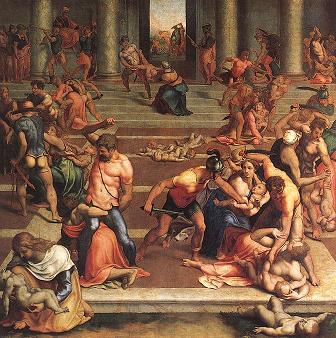 |
17, 18 – Then was fulfilled that which was spoken by Jeremy the
prophet, saying, In Rama was there a voice heard, lamentation,
and weeping, and great mourning, Rachel weeping for her
children, and would not be comforted, because they are not. Bethlehem was the burying place of Rachel, where Jacob marked her grave with a pillar after she died giving birth to Benjamin (Gen. 35:16-20; 48:7). Because Rachel was buried in Bethlehem, she is deemed its spiritual matriarch, and cries out for the children here. Rachel was also the mother of Joseph, whose children, Ephraim and Manasseh, were made tribes in Israel (Gen. 48:5, 6). |
Jacob associated the constitution of Ephraim and Manasseh as tribes in Israel with the death of Rachel (Gen. 48:7), as if God supplied through Joseph what Jacob might have realized in Rachel had she not died. Ephraim was among the northern tribes carried into captivity by the Assyrians. Jeremiah’s prophecy describes Rachel weeping for her children, because they were carried away captive. Despite the loss of her children, Rachel could take comfort in the captivity’s return and the resettlement of the land.
“Thus saith the Lord: A voice was heard in Raham, lamentation,
and bitter weeping; Rachel weeping for her children refused to be
comforted for her children, because they were not. Thus saith
the Lord; refrain thy voice from weeping, and thine eyes from
tears: for thy work shall be rewarded, saith the Lord; and they
shall come again from the land of the enemy. And there is hope
in thine end, saith the Lord, that thy children shall come again
to their own border.” Jer. 31:15-17
The return of the captivity, in
turn, anticipates the New Testament and coming of Christ: God
would bring again the captivity and make a new covenant with
Israel and Judah, first, in marrying again the bride he put away
by the captivity, but ultimately by the new covenant inaugurated
by the death of Jesus Christ (Jer. 31:27-34; Heb. 8:8-12). It is
this latter, plenior
sensus (fuller sense) of Jeremiah’s prophecy that Matthew
here affirms was fulfilled in the slaughter of Bethlehem’s
babes.
19 – But when Herod was dead,
Josephus tells us that Herod died in the seventieth year of his life,
“the fifth day after he had caused Antipater to be slain; having
reigned, since he had procured Antigonus to be slain thirty-four
years; but since he had been declared king by the Romans,
thirty-seven.”[34]
For many years the great majority of writers assumed Herod died in 4 B.C. However, the weight of current scholarship now holds that Herod died shortly before Passover 1 B.C. Evidence placing Herod’s death in 1 B.C., and where we may place the birth of Christ, may be seen in the following table, itemizing events in Roman history and the life of Herod
|
Year B.C. |
Event in Roman Empire/Life of Herod |
Antiquities of the Jews / Citation |
|
72 |
Herod born. |
XIV, ix, 2 |
|
63 |
Pompey the Great captures
Jerusalem Tishri 10. |
XIV, iv |
|
49 |
Julius Caesar makes war
against Roman senate and Pompey the Great. |
XIV, vii, 4 |
|
48 |
Pompey’s forces defeated
at battle of Pharsalus. |
|
|
48 |
Pompey killed in Egypt;
Caesar’s Alexandrian War. |
XIV, viii, 1, 2 |
|
47 |
Caesar makes Antipater,
father of Herod, procurator of Judea; Herod given charge
of Galilee at age 25. |
XIV, viii, 3, 4; ix, 2 |
|
44 |
Caesar assassinated; Marc
Antony and Octavian make war against Cassius and Brutus. |
|
|
42 |
Cassius and Brutus
defeated at Philippi. |
XIV, xii, 2 |
|
41 |
Marc Antony comes into
Asia; falls in love with Cleopatra; Herod and his
brother, Phasaelius made tetrarchs. |
XIV, xiii, 1 |
|
39 |
Parthians invade
Palestine; capture Phasaelius and Hyrcanus; install
Antigonus as king; Herod flees to Rome where he is made
king. |
XIV, xiii, 5-10; xiv,
1-5; |
|
38 |
First regnal year of
Herod; marches on Jerusalem; army goes into winter
quarters. |
XIV, xv, 1-3 |
|
37 |
Herod clears Galilee of
robbers and brigands; army goes into winter quarters a
second time. |
XIV, xv, 4 |
|
36 |
Herod captures Jerusalem
Tishri 10, 27 years to the day after Pompey took the
city; Antigonus executed by Antony, ending Hasmonean
dynasty 126 year after it began 162 B.C. Hyrcanus held
high priesthood 24 years from Pompey; Antigonus held if
3 years 3 months, or 27 years between them. |
XIV, xvi, 1-4; XX, x, 1 |
|
31 |
Battle of Actium
(September) occurs during Herod’s seventh year . This
would be the sixth year of Herod’s reign if capture of
Jerusalem dated to 36 B.C., but seventh according to
Josephus’ erroneous consular and Olympiad dates (37 B.C.). It
would also be the seventh if reckoned as Herod’s regnal
years from Tishri 38 B.C., having been made king in Rome
the winter of 39 B.C. |
XV, v,
2 |
|
30 |
Antony and Cleopatra die;
Herod well received by Octavian, who adds Gadara,
Hippos, and Samaria, and the maritime cities of Gaza,
Anthedon, Joppa, and Strato’s Tower to Herod’s kingdom. |
XV, vii, 3 |
|
26 |
In honor of title
“Augustus” given to Octavian by Roman senate January 27
B.C., Herod renames Samaria “Sebaste” and undertakes its
fortification and improvement. |
XV, viii, 5 |
|
26-25 |
There are two years of
famine beginning the 13th year of Herod’s
reign. |
XV, ix, 1 |
|
20 |
Augustus Caesar comes
into Syria during 18th year of Herod’s reign.
Herod undertakes rebuilding of temple in 18 year of his
reign (13th year per Wars, I, xxi. 1). |
XV, x, 3; XV, xi, 1 |
|
11 |
Caesarea Sebaste
completed in Herod’s 28th year in the 192d
Olympiad |
XVI, v, 1 |
|
2 |
Beginning of the 34th/37th
year of Herod’s reign; Augustus declared
“Pater Patriae”
by senate and people of Rome (Feb. 5); registration
under Saturninus (and Cyrenius); Antipater travels to
Rome where he remains seven months; Joseph and Mary
travel to Bethlehem; Jesus born 4th Quarter
December, 2 B.C. |
XVII, ii, 4; iii, 2; iv,
3 |
|
1
January |
Varus replaces Saturninus
as president of Syria; trial of Antipater before Herod
and Varus.
Herod falls into his last illness; makes new will; Jews
remove Roman eagle over temple gate; rabbis burned to
death; that night (Jan. 10th) there was a lunar eclipse. |
XVII, v; XVII, vi, 1-4 |
|
February
1st Quarter |
Jesus’ presentation at
temple (Feb. 2); offerings for Mary’s ritual impurity;
holy family returns to Nazareth. |
Lk. 2:22-24, 39 |
|
February
2nd Quarter |
Magi arrive in Jerusalem;
are sent to Bethlehem by Herod; star directs instead to
Nazareth; flight to Egypt. |
Matt. 2:1-13 |
|
February
3rd Quarter |
Herod leaves Jerusalem;
travels to mineral springs at Callirrhoe beyond the
Jordan River. |
XVII, vi, 5 |
|
March
2nd Quarter |
Herod returns to palace
at Jericho; orders principle men of Jews to be shut up
in Hippodrome and to be slain at his death. |
XVII, vi, 5 |
|
March
3rd Quarter |
Letters come from Caesar
giving Herod authority to execute Antipater; Herod
orders Antipater’s execution, Slaughter of the
Innocents; amends will, naming Archelaus king; dies five
days later. |
XVII, vii; viii, 1; Matt.
2:16-18 |
|
March
4th Quarter |
Herod’s funeral and
mourning; Archelaus provisionally assumes government,
pending confirmation of Herod’s will by Caesar. |
XVII, ix, 1-2 |
|
April
2nd Quarter |
Passover of the Jews
(April 8th); sedition of Jews over execution of rabbis
by Herod; 3,000 Jews slain by Archelaus in attempt to
suppress sedition. Archelaus and royal family sail to
Rome for confirmation of Herod’s will. |
XVII, ix, 3-7 |
|
June
|
Judea marked by tumults
and disturbances beginning at Pentecost, which are
quieted by Varus; Jews send ambassadors to Rome to
petition to live at liberty under their own laws, and
not under the government of Archelaus. |
XVII, x, 2-10; xi, 1, 2 |
|
July |
Caesar confirms Herod’s
will; makes Archelaus ethnarch of half of Herod’s
kingdom; the other half is divided between Herod Philip
and Herod Antipas. |
XVII, xi, 4 |
|
Aug.-Dec. |
Archelaus assumes
government of Judea; Holy family returns from Egypt,
turns aside to Nazareth. |
Matt. 2:19-23 |
We have placed Jesus’ birth in
the final quarter of December, 2 B.C. (the traditional date of
December 25th), as this seems to be recommended by the
chronology. We know the Magi had to arrive
after the holy family
returned to Nazareth about forty-five days following Jesus’
birth, but before Herod left Jerusalem and travelled to the
mineral springs at Callirrhoe beyond the Jordan River.
Therefore, assuming there
was no extended period between the return to Nazareth and the
arrival of the Magi, and the arrival the Magi and Herod’s
departure from Jerusalem, we should be able to reckon backward
from Passover following Herod’s death to his departure from
Jerusalem, and from there to find the date of the Nativity. Here
are the events as given by Josephus from Herod’s departure from
Jerusalem until Passover, 1 B.C., and the approximate time for
their accomplishment as given by Steinmann[35]:
|
Event |
Days Elapsed |
Total Minimum Days Elapsed |
|
Herod’s physicians tried
many remedies |
1 day minimum (more
likely 2-3 weeks) |
1 (more likely 14-21) |
|
Travel from Jericho to
Callirrhoe (about 50 miles) |
3 days minimum |
4 |
|
Treatment at Callirrhoe |
1day minimum (more likely
1 week or more) |
5 (more likely 11 or
more) |
|
Return to Jericho |
5 day minimum |
8 |
|
The Jewish elders
throughout Herod’s realm are summoned |
6 days minimum |
14 |
|
Herod receives permission
to execute Antipater and has him executed |
1 day minimum |
15 |
|
Herod’s death five days
later |
5 days |
20 |
|
Funeral arrangments and
funeral |
5 days minimum |
25 |
|
Seven days of mourning |
7 days |
32 |
|
Feast in Herod’s honor |
1 day |
33 |
|
Archelaus’ inintal
governance |
7 days |
40 |
|
The Passover |
1 day |
41 (more likely 62) |
Steinmann is mistaken in one
point of his chronology: Steinmann has Herod already at Jericho
when the rabbis are executed and leaves from there for the
mineral springs at Callirrhoe. (see footnote 26, above). This is
based upon a misreading of Josephus where he says that, when the
treatment at Callirrhoe failed, Herod returned to Jericho. But
this merely refers to Herod’s passing through Jericho on the way
to Callirrhoe, and does not indicate Herod originally set out
from there. Josephus is clear that Herod sent the rabbis to
Jericho for execution, showing Herod himself was not there.
Hence, Herod’s journey to the mineral springs at
Callirrhoe must have originated from Jerusalem shortly after the
arrival of the Magi.
Otherwise accepting Steinmann’s
numbers as good approximations, let us say that forty-one days
was the minimum period from Herod’s departure for Callirrhoe
until Passover, but sixty-two days as more likely. Using this
latter figure, then, we find that sixty-two days from Passover,
April 8th, brings us to February 5th. This would be the putative
date Herod departed from Jerusalem for the mineral springs. If
we then reckon backward three days (the period necessary for the
Holy Family to travel from Jerusalem to Nazareth), this would
bring us to February 2nd, the traditional date of the
Presentation of Christ at the temple. If we reckon backward
forty-days more (the period of ritual impurity before the
Presentation of Christ at the temple) we arrive exactly at
December 25th.
We are certain Steinmann did not intend this result or even realize the date of Christ’s birth lay before him this way. Steinmann was concerned solely with the chronology of Herod’s reign, and therefore never gave thought to carrying the chronology of Herod’s last illness and death backward to find the date of Jesus’ birth. But there it is all the same. The traditional date of Christ’s nativity is fully authenticated quite unintentionally by this noted scholar. And this result will not be greatly changed even if we use the minimum number of days Steinmann allotted. By allowing a short time between the holy family’s arrival at Nazareth before the Magi arrive, and between the Magi’s arrival and Herod’s quitting Jerusalem (as we have in our own table, above), the Nativity would still very probably fall on or near December 25th. The same result obtains based upon Luke’s and John’s chronology of Jesus’ baptism and first disciples.
Jewish law and convention
required that men be thirty years old before beginning active,
public teaching (Num. 4:3, 23). Luke says Jesus was on the
threshold of his thirtieth birthday (“began to be”) when he was
baptized by John in the River Jordan (Lk. 3:23). Jesus had a
three and a half year ministry beginning at his baptism and
ending with his crucifixion Good Friday, Nisan 15, A.D. 33. If
we reckon backward three and a half years (forty-two lunar
months, the Jews used a lunar calendar) from Jesus’ crucifixion,
that will bring us to Heshvan 15, A.D. 29., the fifteenth year
of Tiberius (Lk. 3:1) (A.D. 32 was a leap year of thirteen
months). Heshvan 15 that year translates into November 8th,
which thus becomes the date of Jesus’ baptism. Jesus then
underwent a period of fasting and temptation in preparation for
his ministry (Lk. 4:1-13). Since it is unlikely Jesus would
erect a barrier to his life’s work by an extended fast, we judge
that his fast and temptation were timed as to end upon his
thirtieth birthday, allowing him immediately to begin teaching
once these were out of the way. Jesus’ fast was forty days long.
That brings us to December 18th. If we allow one week
for the temptation, during which he hungered and was tempted to
turn stone into bread, then travelled to a high mountain and was
shown the kingdoms of the world, then to Jerusalem where he was
tempted to throw himself down from a pinnacle of the temple,
that would bring us to December 25th.
Following his fast and
temptation, Jesus returned to John the Baptist at Bethabara,
where he made his first disciples (Andrew, Peter, Phillip and
Nathaniel), showing he was now fully thirty years of age (Jn.
1:26-51). John enumerates seven days (Jn. 1:26, 29, 35, 43; 2:1)
beginning with Jesus’ return to John the Baptist and ending with
the wedding at Cana, where Jesus manifested (Gk.
efanerwsev)
his glory to his disciples by turning water into wine (Jn.
2:1-11). This first miracle is commemorated by the Feast of
Epiphany on January 6th. If we accept this date as
sound (it is mentioned by Clement of Alexandria A.D. 150- 215),
counting backward seven days, we find Jesus would have returned
to John December 31st, already having turned thirty
years old. Jesus’ thirtieth birthday therefore occurred sometime
in the fifty-three day window following his baptism before the
close of the year, most likely at the end of his fast and
temptation.
Thus, whether reckoned backward
from Passover following Herod’s last illness and death, or from
Jesus’ baptism and wilderness fast and temptation to making his
first disciples and the wedding at Cana, the final quarter of
December comes forward as the most likely date of Jesus’ birth.
[36]
behold, an angel of the Lord appeareth in a dream to Joseph in
Egypt, saying, Arise, and take the young child and his mother,
and go into the land of Israel: for they are dead which sought
the young child’s life.
Herod died within about one month
of the holy family’s flight to Egypt. However, it would be
several months before Caesar confirmed Herod’s will and the
government of Judea was settled upon Archelaus. Based upon v.
22, the holy family did not return immediately upon the death of
Herod, but after Archelaus had assumed the government of Judea.
21, 22 – And he arose, and took the young child and his mother,
and came into the land of Israel. But when he heard that
Archelaus did reign in Judaea in the room of his father Herod,
he was afraid to go thither: notwithstanding, being warned of
God in a dream, he turned aside into the parts of Galilee.
“Though the serpent is dead, one of his brood doth reign in his stead.” At Herod’s death, the sons of Herod and the rest of the royal family sailed to Rome, where the parties disputed who should reign in place of Herod. Following the conviction of Antipater, Herod changed his will, naming Herod Antipas heir of his kingdom, but after Antipater’s execution, he changed his will and made Antipas tetrarch of Galilee and Berea, but granted the kingdom to Archelaus, making Philip tetrarch of Gaulonitis and Trachonitis, and Paneas.[37] Caesar confirmed Herod’s will with modification:
“When Caesar had heard these pleadings, he dissolved the
assembly; but a few days afterwards he appointed Archelaus, not
indeed to be king of the whole country, but ethnarch of one half
of that whcich had been subject to Herod, and promised to give
him the royal dignity hereafter, if he governed that part
virtuously. But as for the other half, he divided it into two
parts, and gave it to two other of Herod’s sons, to Philip and
to Antipas.”[38]
Ten years later, Archelaus was
banished to Vienna, a city of Gaul, for his cruel and tyrannical
rule over the Jews, proving that he was the true son of his
father. Heaven thus warns Joseph to turn aside to Galilee, which
is beyond Archelaus’ jurisdiction, belonging instead to Herod
Antipas, to whom Pilate sent Jesus at his trial (Lk. 23:7).
23 – And he came and dwelt in a city called Nazareth: that it
might be fulfilled which was spoke by the prophets, He shall be
called a Nazarene.
Nazareth had been the holy family’s home from the start; they now return to it where they will remain until Jesus begins his ministry when he reaches thirty years of age. There is no recorded prophecy that the Christ would be from the city of Nazareth. Rather, the sense seems to be that the prophets spoke of Christ by some term belonging to the same root, such that, in dwelling at Nazareth, Jesus bore the name thus foretold. The root of “Nazareth” and “Nazarene” is the Hebrew “ntsr,” or “netzer,” “a branch,” which term Isaiah used of Christ:
“And there shall come forth a rod out of the stem of Jesse, and
a Branch shall grow out of his roots.” Isa. 11:1
Another possibility is the term
“Nazarite,” meaning “separated,” from the vow of consecration
established by Moses (Num. 6). The similarity of the term
“Nazarite” with “Nararene,” although of a slightly different
root (“nzr”), seems to anticipate Christ, who, though not a
Nazarite proper, nevertheless was so set apart and consecrated
to God that the prophetic type might find fulfillment in him. In
short, both of these terms appear to have been set by Divine
arrangement in sacred literature with a view to the name that
would be called upon Christ. Pilate thus wrote the accusation
that hung upon the cross of Christ: “Jesus of Nazareth, King of
the Jews” (Jn. 19:19); this title still appears today on
crucifixes and images of the cross in Latin abbreviation by the
letters “INRI” – “Iesus Nazarenus Rex Iudaeorum.”
[1]
Josephus, Antiquities, XVII, I, 1; Whiston ed.
[2]
Josephus, Antiquities, XVII, ii, 4; Whiston ed.
[3]
Tertullian, Against Marcion, IV, xix; Ante-Nicene Fathers, Vol. 3, p. 378; cf.
Justin Martyr,
Apology, 1, xxxiv, xlvi;
Dialogue with
Trypho, 78.
[4]
See generally, Jack Finegan,
Handbook of
Biblical Chronology, Revised ed. (Hendrickson,
1998), pp. 302-306;
F.W. Farrar, The
Gospel According to St. Luke, (Cambridge, 1882), pp.
62-64.
[5]
As quoted in Finegan, p. 306.
[6]
Josephus, Antiquities, XVIII, vi, 10.
[7]
Josephus, Antiquities, XIX, v, 1.
[8]
Josephus, Antiquities, XIX, viii, 2.
[9]
Josephus, Antiquities, XIX, v, 1; ix, 1-2; XX, i, 1;
v, 2; vii, 3;
Wars, II, xii, 1
[10]
Josephus, Wars, III, iv, 2; V, i, 5.
[11]
Suetonius, Titus, VIII. Dio Cassius, LXV, xv, 4; LXVI, viii, 1. For Josephus’
account of the posterity of Herod the Great, see
Antiquities, XVIII, v, 4
[12]
I Macc. 13:41, 42.
[13]
Josephus, Antiquities, XIV, i-ix, 2.
[14]
Josephus, Antiquities, XIV, xii-xiv, 5. Josephus’ Olympiad dates do not agree
with his consular dates. The one hundred eighty-fourth
Olympiad ended June 30, 40 B.C., but Calvinus and Pollio
were not made consuls until after the Treaty of
Brundisium on October 2, 40 B.C. Hence, it is probable
that Herod received his appointment in December 40 B.C.,
during the one hundred eighty-fifth Olympiad. (See
Ormond Edwards, “Herodian Chronology”
PEQ 114 (1982) 29-42, p. 30; Andrew E. Steinman, “When Did Herod
Reign” Novum
Testamentum 51 (2009) 1-29, p. 7).
[15]
Appian, Civil Wars, 5.8.75. Sections 69-76 cover the years 39 B.C. as may be
seen by comparison with Dio Cassius’
Roman History.
[16]
Josephus, Antiquities, XIV, xvi, 4. The period of twenty-seven years is
corroborated by the time Hyrcanus served as high priest
from appointment by Pompey, which Josephus gives as 24
years, plus three years and three months the office was
held by Antigonus.
Antiquities, XX, x,
1.
[17]
Dio Cassius,
Roman History
49.23.1-2.
[18]
Josephus, Antiquities, XIV, xvi, 4; XX, x, 1.
Steinman, When Did
Herod Reign, p. 9.
[19]
Josephus, Antiquities, XX, x, 1; Whiston ed.
[20]
Herodotus, 100, 107.
[21]
The rulers of the Jews knew and understood Aramaic when
speaking with the Assyrians ambassadors (II Kng. 18:26).
[22]
Johannes Kelper, De anno
natali Christi
(1614). Earnest L. Martin,
The Star that
Astonished the World (ASK Publications, 1996); Craig
Chester, President, Monterey Institute for Research in
Astronomy, The Star of Bethlehem, IMPRIMIS
(Hillsdale College) December 1993; John Mosley,
Program Supervisor, Griffith Observatory, Common
Errors in "Star of Bethlehem" Planetarium Shows, The
Planetarian, Third Quarter 1981.
[23]
Josephus, Antiquities, XV, x, 4; Whiston ed.
[24]
Josephus, Antiquities, XVII, v-vi, 4.
[25]
W. E. Filmer, The
Chronology of the Reign of Herod the Great, JTS 17
(1966), pp. 283-298; Earnest L. Martin,
The Birth of Christ Recalculated (Pasadena: Foundation for Biblical
Research, 1978); idem
The Nativity and
Herod’s Death, CKC 85-92; idem,
The Star that
Astonished the World (2nd ed.; Portland:
ASK Publications, 1996); Jack Finegan,
Handbook of
Biblical Chronology (Revised ed.;
Hendrickson, 1998); Andrew E. Steinmann,
When Did Herod the Great Reign?, Novum Testamentum 51 (2009), pp.
1-29.
[26]
Steinmann is mistaken here, in that he has
Herod already at Jericho when the rabbis are executed
and leaves from there for the mineral springs at
Callirrhoe; but Josephus is clear that Herod
sent the
rabbis to Jericho for execution, showing Herod himself
was not there. The better view is that Magi found Herod
still at Jerusalem shortly after the rabbis’ execution;
Herod then left for Callirrhoe shortly thereafter.
Steinmann, When
Did Herod the Great Reign?, p. 13
[27]
The traditional names Melchior, Caspar, and Belthazar
are thought to derive from a Greek manuscript dated to
about A.D. 500, translated into a Latin document
entitled Excerpta Latina Barbari. “At that time
in the reign of Augustus, on 1st January the Magi
brought him gifts and worshipped him. The names of the
Magi were Bithisarea, Melichior and Gathaspa." Ibid at
p. 51.
[28]
Josephus, Antiquities, XIV, VII, 2; XIV, x, 1, 2.
[29]
“Herod…is best known as the sly and murderous monarch of
Matthew's Gospel, who slaughtered every male infant in
Bethlehem in an unsuccessful attempt to kill the newborn
Jesus… Herod is almost certainly innocent of this crime,
of which there is no report apart from Matthew's
account..” Tom Mueller,
King Herod
Revealed, National Geographic (December 2008) p. 42.
Cf. Rev.
Masson, A Vindication of the Defense of Christianity Vol. II,
The Slaughter of
the Children of Bethlehem, as an Historical Fact of St.
Matthew’s Gospel, Vindicated, (London, 1728).
[30]
Josephus, Antiquities, XVI, vii, 1; Whiston ed.
[31]
Suetonius, Augustus, XCIV, 3; Loeb ed.
[32]
Josephus, Antiquities, XVII, vi, 5; cf.
XV, 1-10.
[33]
Macrobius, Saturnalia, II, 11; Loeb ed.
[34]
Josephus, Antiquities, XVII, viii, 1; Whiston ed.
[35]
Steinmann, When Did Herod the Great Reign?, p. 15, 16. For a copy of Steimann’s
piece, go to
http://www.ingentaconnect.com/content/brill/not/2009/00000051/00000001/art00001
[36]
For a fuller treatment of the date of Christ’s birth,
see the author’s article
“Unto You is Born
this Day: The Biblical Case for the December 25th
Birth of Christ”
www.dec25th.info. See also, the author’s
Tables of Priestly
Courses from 23 B.C. to A.D. 70, demonstrating the
validity of the traditional date based upon Zechariah’s
ministration in the temple.
[37]
Josephus, Antiquities, XVII, vi, 1; viii, 1.
[38]
Josephus, Antiquities, XVII, xi, 4; Whiston ed.
______________________________
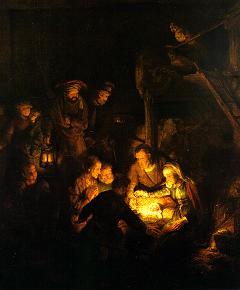
Adoration of the Shepherds
All rights reserved.
 John Seleden’s
John Seleden’s